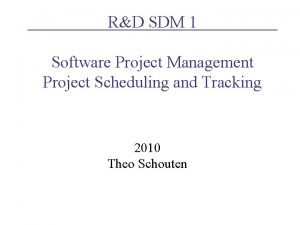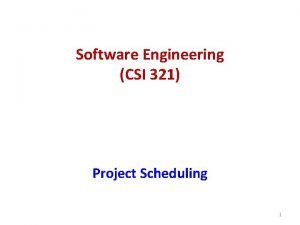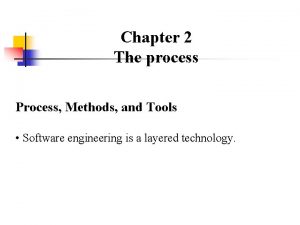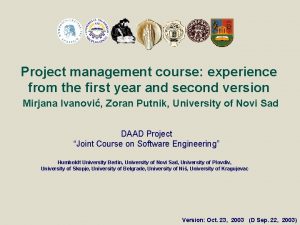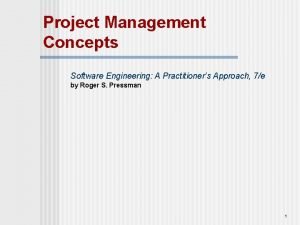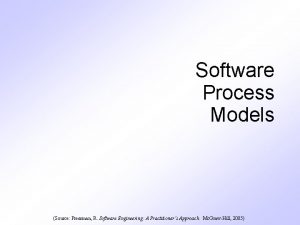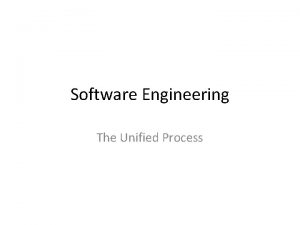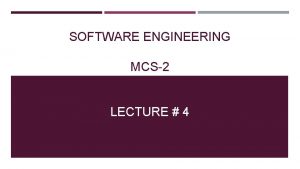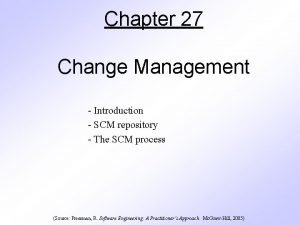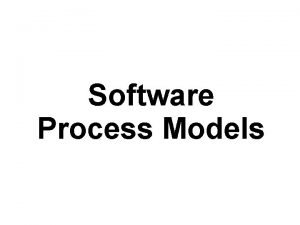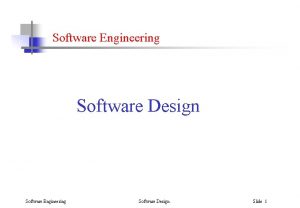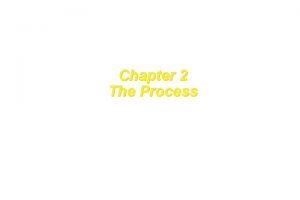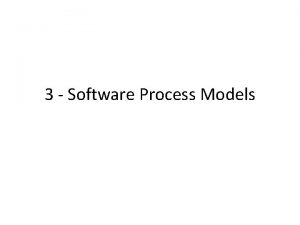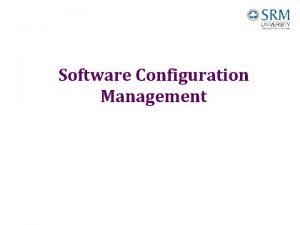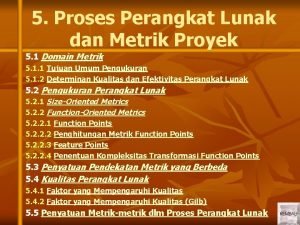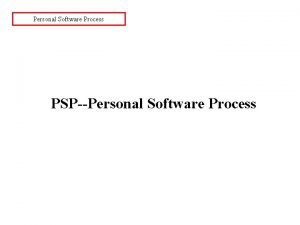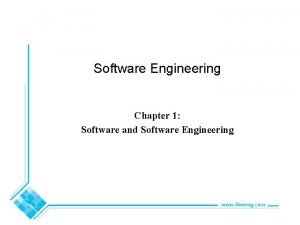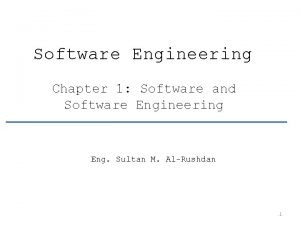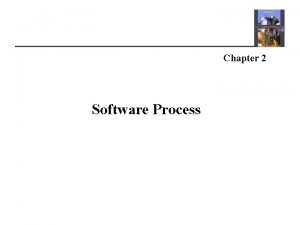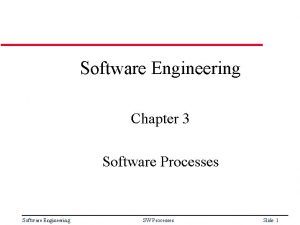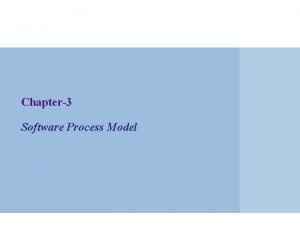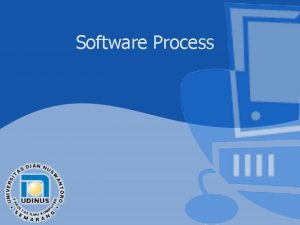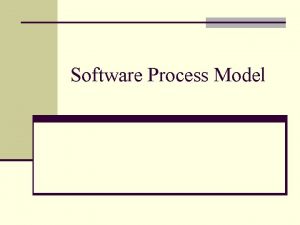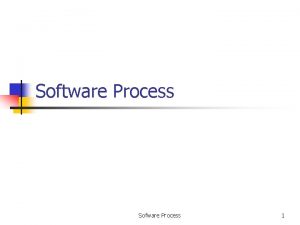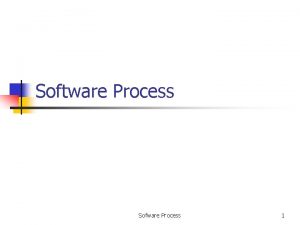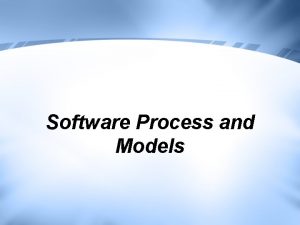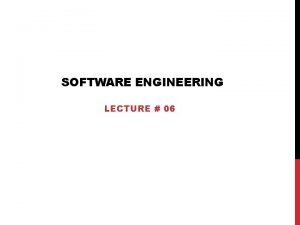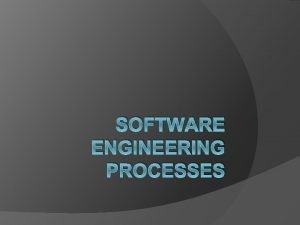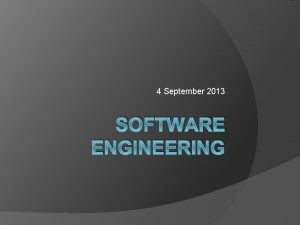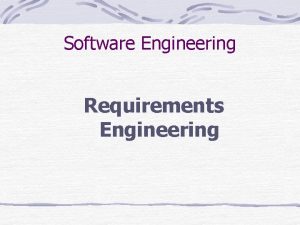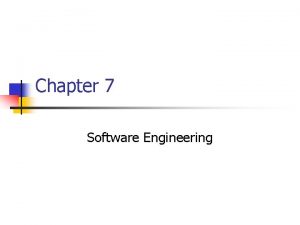Software engineering Chapter 4 Software Process and Project
























- Slides: 24

Software engineering Chapter 4 Software Process and Project Metrics By: Lecturer Raoof Talal

4 -1 Measures, Metrics, and Indicators Although the terms measure, measurement, and metrics are often used interchangeably, it is important to note the subtle differences between them. Within the software engineering context, a measure provides a quantitative indication of the extent, amount, dimension, capacity, or size of some attribute of a product or process. Measurement is the act of determining a measure.

When a single data point has been collected (e. g. , the number of errors uncovered in the review of a single module), a measure has been established. Measurement occurs as the result of the collection of one or more data points (e. g. , a number of module reviews are investigated to collect measures of the number of errors for each).

Software metric relates the individual measures in some way (e. g. , the average number of errors found per review or the average number of errors found person- hour expended on reviews. A software engineer collects measures and develops metrics so that indicators will be obtained. An indicator is a metric or combination of metrics that provide insight into the software process, a software project, or the product itself.

4 -2 Metrics in the Process and Project Domains Measurement is commonplace in the engineering world. We measure power consumption, weight, physical dimensions, temperature, voltage, signal-to-noise ratio … the list is almost endless. Unfortunately, measurement is far less common in the software engineering world. We have trouble agreeing on what to measure and trouble evaluating measures that are collected.

Process metrics are collected across all projects and over long periods of time. Their intent is to provide indicators that lead to long-term software process improvement. Project indicators enable a software project manager to: (1) assess the status of an ongoing project. (2) track potential risks. (3) uncover problem areas before they go “critical, ”. (4) adjust work flow or tasks. (5) evaluate the project team’s ability to control quality of software work products.

In some cases, the same software metrics can be used to determine project and then process indicators. In fact, measures that are collected by a project team and converted into metrics for use during a project can also be transmitted to those with responsibility for software process improvement. For this reason, many of the same metrics are used in both the process and project domain.

4 -2 -1 Process Metrics The only rational way to improve any process is to measure specific attributes of the process, develop a set of meaningful metrics based on these attributes, and then use the metrics to provide indicators that will lead to a strategy for improvement. But before we discuss software metrics and their impact on software process improvement, it is important to note that process is only one of a number of factors effecting on improving software quality and organizational performance.

Referring to Figure 4. 1, process sits at the center of a triangle connecting three factors that have an influence on software quality and organizational performance. • The skill of people has been shown to be the single most influential factor in quality and performance. • The complexity of the product can have a substantial impact on quality and team performance. • The technology (i. e. , the software engineering methods) that populates the process also has an impact.

In addition, the process triangle exists within a circle of environmental conditions that include: • The development environment (e. g. , CASE tools). • Business conditions (e. g. , deadlines, business rules). • Customer characteristics (e. g. , ease of communication).


4 -2 -2 Project Metrics Software process metrics are used for strategic purposes. Software project measures are tactical. That is, project metrics and the indicators derived from them are used by a project manager and a software team to adapt project work flow and technical activities.

The first application of project metrics on most software projects occurs during estimation. Metrics collected from past projects are used as a basis from which effort and time estimates are made for current software work. As a project proceeds, measures of effort and calendar time expended are compared to original estimates (and the project schedule). The project manager uses these data to monitor and control progress.

As quality improves, defects are minimized, and as the defect count goes down, the amount of rework required during the project is also reduced. This leads to a reduction in overall project cost. A model of software project metrics suggests that every project should measure: • Inputs: measures of the resources (e. g. , people, environment) required to do the work. • Outputs: measures of the deliverables or work products created during the software engineering process. • Results: measures that indicate the effectiveness of the deliverables.

4 -3 Software Measurements in the physical world can be categorized in two ways: direct measures (e. g. , the length of a bolt) and indirect measures (e. g. , the "quality" of bolts produced, measured by counting rejects). Software metrics can be categorized similarly

Direct measures of the software engineering process include cost and effort applied. Direct measures of the product include lines of code (LOC) produced, execution speed, memory size, and defects reported over some set period of time. Indirect measures of the product include functionality, quality, complexity, efficiency, reliability, maintainability, and many other "–abilities".

The cost and effort required for building software, the number of lines of code produced, and other direct measures are relatively easy to collect. However, the quality and functionality of software or its efficiency or maintainability are more difficult to assess and can be measured only indirectly.

Consider a simple example. Individuals on two different project teams record all errors that they find during the software process. Individual measures are then combined to develop team measures. “Team A” found 342 errors during the software process prior to release. “Team B” found 184 errors. All other things being equal, which team is more effective in uncovering errors throughout the process? Because we do not know the size or complexity of the projects, we cannot answer this question. However, if the measures are normalized, it is possible to create software metrics that enable comparison to broader organizational averages.

4 -3 -1 Size-Oriented Metrics Size-oriented software metrics are derived by normalizing quality and/or productivity measures by considering the size of the software that has been produced. If a software organization maintains simple records, a table of sizeoriented measures, such as the one shown in Figure 4. 2, can be created. The table lists each software development project that has been completed over the past few years and corresponding measures for that project.


Referring to the table entry (Figure 4. 2) for project alpha: • 12, 100 lines of code were developed • 24 person-months of effort • at a cost of $168, 000. It should be noted that the effort and cost recorded in the table represent all software engineering activities (analysis, design, code, and test), not just coding.

Further information for project alpha indicates that • 365 pages of documentation were developed, • 134 errors were recorded before the software was released, • 29 defects were encountered after release to the customer within the first year of operation. • Three people worked on the development of software for project alpha.

In order to develop metrics that can be assimilated with similar metrics from other projects, we choose lines of code as our normalization value. From the rudimentary data contained in the table, a set of simple size-oriented metrics can be developed for each project:

• Errors per KLOC (thousand lines of code). • Defects 4 per KLOC. • $ per LOC. • Page of documentation per KLOC. In addition, other interesting metrics can be computed: • Errors person-month. • LOC person-month. • $ per page of documentation.
 Process and project metrics in software engineering
Process and project metrics in software engineering Sdm project management
Sdm project management Pnr curve in software engineering
Pnr curve in software engineering Process methods and tools
Process methods and tools System architecture example
System architecture example Forward engineering and reverse engineering
Forward engineering and reverse engineering What is software measurement
What is software measurement Software process and project metrics
Software process and project metrics Environmental resources in software engineering
Environmental resources in software engineering Project management lecture
Project management lecture Project management tools in software engineering
Project management tools in software engineering 4 p's of project management in software engineering
4 p's of project management in software engineering 4 p's of project management in software engineering
4 p's of project management in software engineering Software process models
Software process models Unified process model in software engineering
Unified process model in software engineering Prototyping process in software engineering
Prototyping process in software engineering What is scm repository
What is scm repository Generic process model diagram
Generic process model diagram Cohesion in software engineering
Cohesion in software engineering Umbrella activities in software engineering
Umbrella activities in software engineering ___________________ is a series of predictable steps.
___________________ is a series of predictable steps. Agile view of process in software engineering
Agile view of process in software engineering Linear process model in software engineering
Linear process model in software engineering Scm in software engineering
Scm in software engineering Project metrics examples
Project metrics examples

